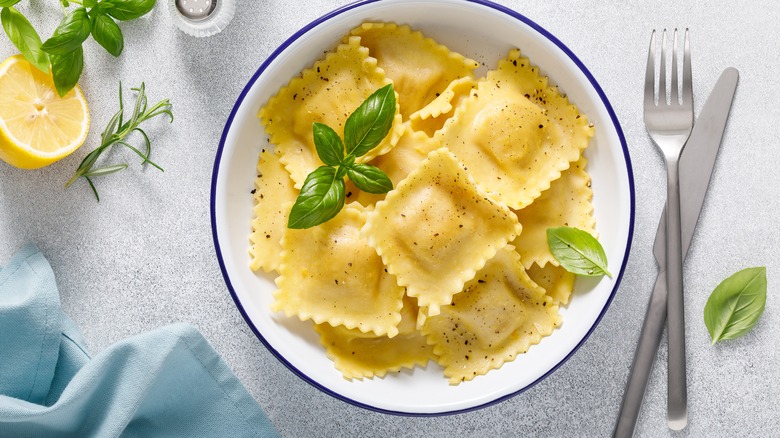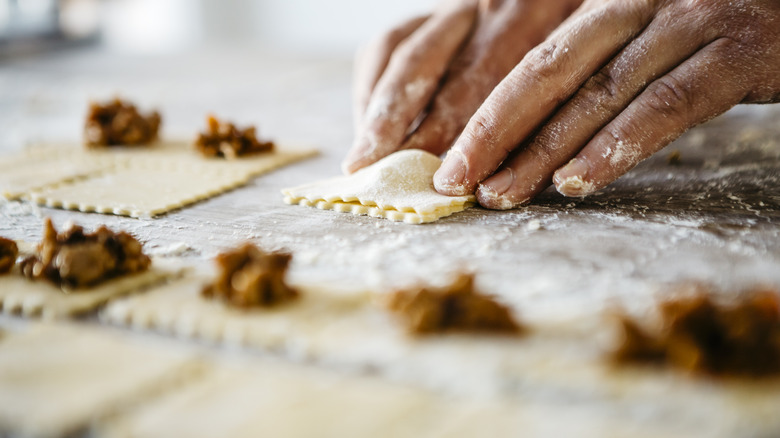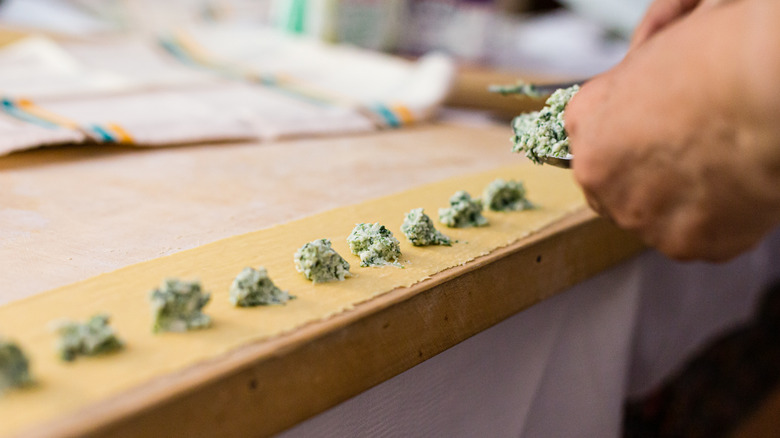How Raw Vegetables Can Totally Ruin Your Ravioli Filling
Ravioli can be a joy to make, not to mention a great chance to get creative with your favorite ingredients. You can even use up veggies you have lingering in the crisper to create a dish like homemade ravioli with ricotta cheese and spinach filling. But one tip to help you avoid a major stuffed pasta pitfall is to never fill your ravioli with raw vegetables.
Vegetables like tomatoes, mushrooms, spinach, zucchini, cauliflower, eggplant – and many others commonly used as ravioli filling — have a super high water content. Too much moisture in the filling can ruin your ravioli, as it can cause your pasta to leak during the boiling process or even fall apart in the water. While your filling may feel securely tucked into your pasta when you prepare it, the raw vegetables inside will begin to release moisture during cooking.
This is where pre-cooking the vegetable filling ingredients comes in handy to help eliminate some of that moisture. If you want to make your truly authentic ravioli bursting with the tasty flavors of your favorite veggies, the simple fix is to take one extra step and roast, sweat, sauté, or otherwise cook them down first.
Why moisture can make a mess of your pasta
Cooking the veggies for your filling first makes all the difference for your ravioli, thanks to the process of evaporation. Take mushrooms, for example. If you've ever sautéed mushrooms, you may have found yourself with a pan full of liquid (this happens especially when cooked over low heat). When mixed into filled pasta, that cooking process happens during the boiling stage, which means that's when all that liquid is released, compromising your pasta dough.
You can experiment with different cooking methods for various vegetables (in the case of mushrooms, sautéing over medium-high to high heat will help vaporize that liquid, and following an important tip to give your mushrooms space in the pan helps, too). The goal no matter the vegetable is to help that moisture evaporate before going into your stuffed pasta. This way, you reduce the risk of that water escaping during boiling and the chance that your pasta will fall apart.
Cooking your vegetables before preparing your filling not only removes moisture and makes for a sturdier filling that won't ooze out of your pasta pockets, but concentrates their flavor for an added oomph. It will help the vegetables shine when you've boiled and sauced your pasta.
More tips for preventing ravioli ruin
In addition to pre-cooking your veggies for the ravioli filling, there are a few ways to help you avoid any pasta meltdowns during the cooking process. If a recipe calls for your roasted vegetables to be puréed as a filling, you can also enlist the help of cheese, breadcrumbs, or even flour to help bind them. Once made, it also helps to freeze your finished product, which will prevent your dough from becoming soggy right away.
When you're ready to roll, be sure you're using a pot that's large enough to contain the amount of pasta you're planning to make. If you overfill, there's a chance your ravioli might stick together, which can result in breakage, too. Salting the water also helps ensure these pillowy bites don't become stuck, as does an occasional gentle stir.
You can make fruit-filled ravioli, too, like pear and pecorino, or caramelized fig. Keep in mind that many fruits are super high in water content, too (both of those examples can hover around 80%), so it's a good idea to follow the same cooking tip. By taking that easy extra step to pre-cook your filling ingredients, you can be sure your ravioli will make it to your plate intact.


